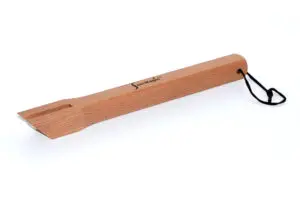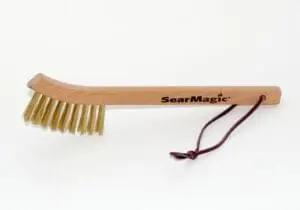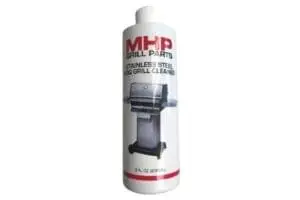Yes, the new cooking grid has the same specs as the original.
Most frequently asked questions and answers
You will save on your utility bill using a gas grill instead of conventional oven or charcoal cooking. Less energy for air-condition, fewer dishes to wash and no charcoal or starter to buy. Charcoal grilling costs 30 times more than natural gas and 10 times more than propane gas to cook an average meal.
The fact is that charcoal does not flavor your outdoor meal, but is only a heat source. The MHP Gas Grill utilizes a special self-cleaning porcelain briquette above the burner that heats up fast and spreads the heat evenly. The delightful backyard taste theat comes with barbecue cooking is caused by meat drippings falling on the heat source where they are vaporized to rise up and add flavor to the food.
Like your kitchen oven, a gas grill is designed to cook with the lid closed, except for quick searing. Cooking with the lid-closed helps food retain natural juices, moisture, enhances flavor and keeps annoying flare-ups to a minimum. Also, heat is reflected from the lid, and foods cook not only from below, but also evenly on all sides from circulating hot air, (similar to convection oven) for faster, more fuel-efficient cooking.
The greatest cause of gas grill cooking failures is excess heat. Understanding the three basic heat setting along with experience, you will find the precise heat you need will become easier and easier to achieve. HIGH- is used primarily for preheating and cleaning. It may also be used for quick searing of meats, such as steaks and chops. MEDIUM- For broiling or quick cooking foods. Also use MEDIUM for searing foods that have been cooked at LOW, for more of a smoke flavor. LOW- Most foods should be cooked at LOW. Even thick steaks, which have been seared on both sides at HIGH, will finish with better texture and more juices at LOW. All roasts, poultry and rotisserie cooking should be at LOW.
Always use long wooden-handle forks, spatulas or tongs, designed especially for outdoor cooking when testing or turning food in your grill. Keep hot pads or mitt handy for removing food from cooking grid. For juicer more flavorful meats, uses tongs when handling and turning. Piercing the meat with a fork allows juices to escape.
You can prepare entire meals in a gas grill…and you’ll love it even more. Baked Potatoes, corn-on-the-cob, stuffed tomatoes, peppers, squash, vegetables, garlic bread, baked apples, pies… grill them on the warming rack or alongside the meat for complete menus.
Aluminum foil is probably the most convenient accessory of all. Foil can be used to cook food on or in. It also serves as a drip pan and heat deflector. Vegetables cook best when wrapped in foil. Foil holds in natural liquids, and foods cook moist and tender. Delicate foods such as fish fillets and seafood may be cooked on foil placed directly on the cooking grid. When spit-cooking foods of uneven shape, smaller parts that may cook too fast, may be wrapped in foil. Foil is also great to use in cleaning the grill. For stubborn grease or sauce build-up that is not removed during your normal cleaning process. Simply place a sheet of aluminum foil covering the Flavor Master briquettes or cooking grids. With the lid open, turn the control to HIGH and ignite, close lid. After about 25 minutes the residue will be reduced to a white powder, which is easily brushed or wiped off after the grill has cooled.
Use an oven-safe meat thermometer when cooking large pieces of meat, poultry and game to determine if cooked adequately. The thermometer should be inserted into the thickest part of the meat. For accurate temperature reading, the tip of the thermometer should not touch fat layers, bone or gristle, or if using the rotisserie, the spit rod. The chart below will provide you with approximate temperatures for the degree of doness for the different kinds of meats.
| Beef | Medium-rare Medium Well-done | 145° F 160° F 170° F |
| Ground Meats (beef, lamb & pork) | Medium Well-done | 160° F 170° F |
| Pork | Medium Well-done | 160° F 170° F |
| Ham | Fully cooked | 140° F |
| Turkey (Whole) (Breast) (Dark meat) | Well-done Medium Well-done | 180° F 170° F 180° F |
| Chicken | Well-done | 180° F |
| Duckling | Well-done | 180° F |
| Lamb | Medium-rare Medium | 150 F° 180° F |
| Sausage (Fresh Bratwurst Italian & Polish) | Well-done | 170° F |
| Veal | Medium Well-done | 160° F 180° F |
Salt, which tends to dry out foods, is best added after cooking. Sauces and marinades add a special taste treat when grilled. Marinades are popular because they turn less expensive cuts of meat into tasty entrees. Large items such as roasts should be marinated at least 8 hours or overnight. Fish, poultry and ribs may be marinated successfully in an hour. Food in the marinade should be turned occasionally and kept cool under refrigeration. Sugar-based glazes and sauces will burn faster and should be brushed on during final stages of cooking or used as a table sauce.
For best results, thaw all meat in the refrigerator. This allows for juicier, more flavorful meats. However, very good results can be obtained by cooking your steaks while still frozen. Just remember to allow more cooking time. The microwave oven provides an alternative for thawing your meat, although it is our least recommended method. Fish and vegetables can be successfully grilled frozen.
All poultry is best cooked at LOW. A meat thermometer should be used to determine doneness in large birds. Smaller pieces are done when no pink juices appear when the flesh is pricked, and in whole birds, when the leg joints turn loosely in their sockets.
In grilling fish, 10 minutes at LOW per inch of thickness is almost perfect timing. When the fish flakes easily with a fork, it is done.
SOME FISH HANDLING AND COOKING TIPS:
- Fish should be brushed with melted butter or oil before placed on the grill. Brush well with more butter or oil several times while it is cooking. Turn once.
- Avoid over handling fish during grilling. Cooked fish is delicate and will flake easily. Turn once.
- With smaller fish or filets, a MHP Sear Magic® grid or wire basket makes turning easier. Coat grid or basket with a non-stick spray for easier handling.
- To grill frozen fish, partially defrost and then cook as you normally would.
- Another way to grill fish is in foil packets. Add lemon juice or white wine for more flavor.
Your model and serial number could be located in a couple of places. It depends on which model Modern Home Product grill you own.
- The model & serial number most typically will be located on the left end cap of your control panel.
- Other models will have the serial number located on the underside of slide-out grease tray.
If you do not hear any clicking when you push the ignitor button, it may be time to replace the battery.
To access the battery, unscrew the ignitor push button and collar. Remove the old battery. If you see any corrosion in the battery compartment it can be removed by wrapping a small piece of sand paper around the eraser end of a pencil and using that to scrape off the corrosion.
Install a new AAA battery into the battery compartment, positive (+) side down. Replace the push button and collar.
Below is a video showing how to replace the battery in the electronic ignitor.
The positive side goes down.
Is that peeling paint on the inside of the grill lid?
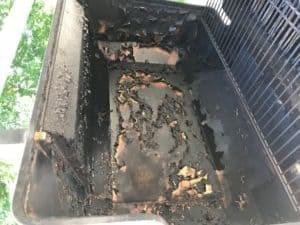
Example of grease build-up on the inside of the grill
There is no paint applied on the inside of your grill lid and not used on the inside of our grills due to the fact that paint is flammable and toxic. What you are seeing is a carbon and grease build-up on the inside of your grill. Remarkably it does resemble the look of peeling paint, but it is simply residue that can be scraped off. There are several ways that your grill lid can be cleaned.
- You can use a wadded up ball of aluminum foil, or a plastic flat blade putty knife to scrape off the majority of the food build-up. The loosened material can be removed with a shop vac.
- You can also take the removal a step further if you would like and use a brass wire wheel to remove any excess residue left in the casting.
- You can also use a garden hose to remove some of the material, but if you do this, first you will need to remove the briquettes and cover your collector box & electrode with aluminum foil so they don’t get wet. After cleaning, once the grill is dry, remove the foil from the collector box and put the briquettes back in place.
- The inside of the grill lid can also be power washed, but you will want to remove the top casting from the grill before you do this, so the water doesn’t damage the ignitor or break the briquettes, or tip the grill over.
No, you should not spray grilling spray on your cooking grids. The grilling spray will burn to your grids and leave a gummy yellow coating that is very hard to remove and cause your food to stick even worse.
If you smell gas and the grill will not ignite you will need to check a couple of things.
- Is my ignitor sparking? You may need to check and replace your battery if you don’t hear a clicking sound.
- If your ignitor module is sparking and your grill still won’t ignite you will need to make sure your wires are secured properly.
- If your ignitor module is sparking and your wires are secured properly you will not need to make sure your ignitor box has not rusted away by your burner.
- If your grill still will not ignite with your ignition system your grill is equipped with a safe alternate method of lighting.
- You may need to light your with a long lighter through the hole that is located in the bottom casting directly under your right side shelf.
- First, put the lighter in the hole and ignite then ignite it once it is near your burner.
- Then turn the right valve knob to the “high” position.
- Finally turn the left valve knob to the “high” position and preheat your grill for 10 minutes.
- Bring on the BEEF
If you have any questions or concerns about your grill, please do not hesitate to contact one of our knowledgeable customer service agents.
Burners are going to rust due to the high heat, salt, and food drippings. This surface rust is not reason enough to replace your burner, however. Your annual maintenance should include a thorough investigation and cleaning of your burner. When you take your burner out you should remove the surface rust on the burner with a wire brush.
Below are several problems that will indicate your burner needs to be replaced.
- Large gaping holes on the underside of your burner rather than individual round ports.
- Leg pins and blocks fell out of the bottom of your burner.
- Split seams along the edge of your burner.
If you are unsure if your burner needs to be replaced, please do not hesitate to contact one of our knowledgeable customer service agents.
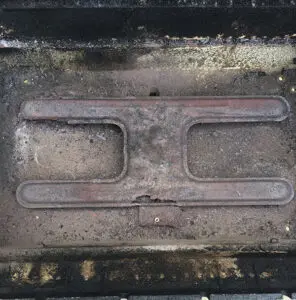
Example of a burner with gaping holes on the burner
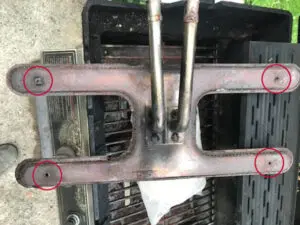
Example of a burner with missing or broken leg pins
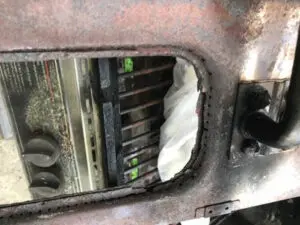
Example of a burner with split seams along the bottom of the burner
For painting the outside of your cast aluminum grill, we recommend choosing a good quality high-temperature paint specifically designed for use on metal surfaces.
When repainting the outside of your grill you want to make sure that you remove all the grease and debris thoroughly to ensure that your paint adheres properly to the following steps.
- Tape off or remove anything you do not want to paint on your grill. (control panel, logos, handle, etc…)
- Wash the grill with hot soapy water, rinse, and dry.
- Use a degreaser and then steel wool.
- Wipe down the grill with a lint-free cloth before painting with a high-temp grill paint.
Yes! Anodized aluminum is perfectly safe to cook on.
Exposures to aluminum through food can occur when aluminum leaches or otherwise dissolves from the cookware into the food. Leaching is most likely when the foods being cooked or stored are highly basic (like baking soda) or highly acidic (like tomato sauce, lemon juice, oranges, or vinegar). For example, tomato sauce has been shown to contain 3-6 mg aluminum (per 100 g serving) after cooking in aluminum pans, which translates into about one-tenth of the typical daily intake. This leaching of aluminum with acidic foods does not happen with aluminum cookware that is anodized or electrochemically processed to seal the aluminum in the cookware. Clemson University Extension’s Home and Garden Information Center tested different cookware types and found anodized aluminum cookware to be safe.
In some areas of the country, spiders or small insects have been found to create “flashback” problems. The spiders spin webs and/or insects build nests in the grill’s venturi tube(s). The web and/or nests can lead to gas flow obstruction which results in a “flashback” (a fire in the venturi tube(s). See illustration below.
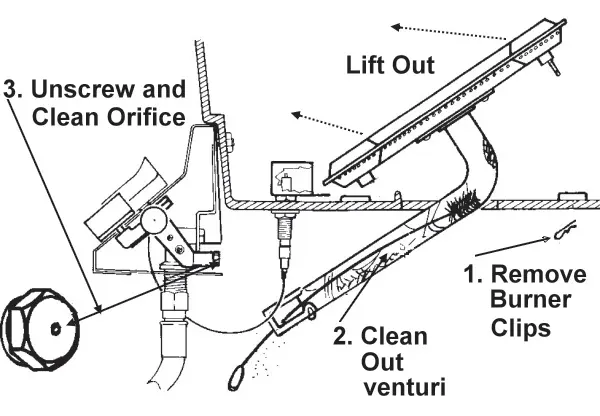
The grill may still light, but the obstruction does not allow full gas flow to the burner. Therefore, some gas will back up and escape at the venturi shutter. This will ignite, causing flashbacks, which also could damage your grill.
To remove spider webs and/or other obstructions, you must remove the burner and clean out the venturis with the long narrow bottle brush supplied with the grill. This should be done routinely after the grill has set idle for extended periods.
- Be sure the grill is cold. Open the lid and remove the cooking grids, the porcelain briquettes and the briquette grate.
- Under the grill, remove the clips holding the burner in place.
- Lift the burner and venturi assembly out. With the bottle brush supplied, or a pipe cleaner or long flexible wire, clean out the venturi tubes.
- Remove the hex head orifice with a 3/8″ wrench. Clean orifice hole and inner part of the valve with a toothpick being careful not to enlarge the orifice hole.
- Before reinstalling the hex head orifice to the valve stem, use a quick burst of gas pressure by turning the valve on then off to remove any loose debris.
- When replacing the burner/venturi assembly, be sure the venturis fit over the gas valve orifices.
- Reinstall the clips under the grill to hold the burner in place.
This is called a Flashback. Flashbacks are caused by an obstruction in either your venturi tubes or in the orifices.
To convert a JNR, WNK or TJK from one gas type to another you will need to replace the entire valve assembly (which includes the correct orifice).
- If you were only to only change the orifice on your valve, you will not have control over the variable heat settings on your grill because internally the valves are tooled differently per gas type. Your grill will burn on high at all times and you will not be able to turn it to low.
- If you are unsure, please contact our knowledgeable staff to determine which conversion kit you will need for your conversion.
You should never put food over your infrared burner if the burner is not lit.
The infra-red burners are designed to incinerate the drippings from your food. If the burner is not turned on this drippings will rest on your burner and clog the burner preventing proper air flow the next time you use your grill preventing the infra-red burner for working properly. In some cases, this will cause the ceramics to crack resulting in the need for a new burner.
You will need to get your infrared burner replaced.
You will want to clean out your infrared burner venturi with the venturi tube cleaner that was supplied with your grill. If you experience the same popping when you reinstall your burner it may be that you have a cracked ceramic or broken seal. If this is the case, you will need to replace your infrared burner with a new one.
You should not wash your briquettes with soap and water.
Because your Flavormaster briquettes are made of porcelain the water will cause your briquettes to shatter if not thoroughly dry before using. Your self-cleaning Flavormaster briquettes are designed to be flipped over once or twice a season where any food debris will cook off.
No, you should not use compressed air—by using the air you are not removing the obstruction just blowing it out of the way. Instead, you will want to use the provided venturi tube brush to clean your venturis.
Because these burners are constructed of cast stainless steel, over time you may notice the portholes are closing up due to calcification. To keep your burner working properly year after year you will want to inspect these burners each season and clean off all of the calcification with a wire brush. If you have neglected to do this grill maintenance you may notice your ports are severely clogged and you can attempt to unclog each of these ports by either drilling them out with a drill or the use of a sandblaster.
While your grill is turned off you can try removing your knobs and spray a lubricant directly on the valve stems. You can then replace your knobs and work the lubricant into your valve by pushing in the knob and turning back and forth several times. If you notice that the valve is still difficult to turn you will need to replace your valve.
If you have any questions or concerns about your grill, please do not hesitate to contact one of our knowledgeable customer service agents.
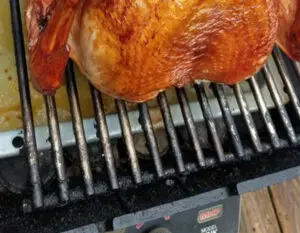
There are several ways you can clean your stainless steel cooking grids.
- You can use a brass bristle brush or balled up aluminum foil to scrap and clean your grids when they are hot.
- You can use hot soapy water to soak your grids and then use a nylon scrubby pad.
- You can also use oven cleaner to clean your grids.
- You can put the cooking grids into a large black plastic garbage bag, add enough vinegar to cover your grids, seal the garbage bag and then place in the hot sun for several hours. When you take the grids out you can wash them with hot soapy water and a nylon scrubby to remove any additional debris.
- DO NOT put your grids in a self-cleaning oven.
The first time you use your SearMagic grids you will want to run your grill on high to burn off any oils that may be on your grids.
Because your grids do not have a non-stick coating on them, here are a couple of suggestions to get the most out of your first SearMagic grilling experience.
- The best thing to cook on your grids to get them seasoned would be something that has a higher fat content like burgers. The fat in the burgers will help to season your grids for future grilling. The more you use them the better they get.
- When grilling something like boneless, skinless chicken breasts you should coat your chicken with something like light olive oil to prevent your chicken from sticking.
If you have any questions or concerns about your SearMagic grids, please do not hesitate to contact one of our knowledgeable customer service agents.
Yes, SearMagic grids can warp.
Warping is usually caused by cooking with a burner that has a split in the seam, allowing a larger flame to come through at the split. This is called a hot spot. When a burner starts to split, it needs to be replaced. Otherwise, the cooking grids will continue to warp.
How do I fix warped SearMagic Cooking Grids?
To fix warped SearMagic cooking grids, you will need to heat them in the grill on high for about 10 to 15 minutes. Using oven mitts, remove your grids one at a time and wrap in an old towel. Next set them on a flat surface such as a sidewalk and press down on the high spots until flat. You may need to repeat this process several times depending on how severe the warping has become.
The way to keep the cooking grids from warping again is to be sure to inspect your burner at the beginning of each grilling season and replace the burner if the seam starts to split.
The warranty covers the cooking grids against a manufacturing defect, such as a weld pop. The warranty specifically excludes warping, which is explained in the Maintenance section of the owners’ manual.
No, you should not put your cooking grids in the dishwasher or self-cleaning oven.
Your cooking grids are full of debris and will potentially ruin your dishwasher and the high temperatures of the heat drying cycle could potentially warp your grids. The extreme temperatures of the self-cleaning cycle in your oven could melt your SearMagic grids making them unusable.
DO NOT use oven cleaner on your SearMagic grids either. This will pit the metal and jeopardize the integrity of the grid.
Due to the intense heat that is generated by the burner ignitor boxes can prove to be quite difficult to remove. Over time the nut that holds the ignitor box in can become corroded and hermetically sealed to your bottom casting. Below are a some recommended steps to assist in successfully removing your GGIB.
- First, soak the nuts on both the underside and inside of your bottom casting with a penetrating oil like WD-40 or Liquid Wrench. Let this soak for several hours and you may want to give these areas a couple of doses of the penetrating oil.
- If you have not been able to remove the ignitor box after soaking in penetrating oil you can try tapping or chiseling it out.
- Another suggestion to remove a stubborn ignitor box is to drill it out once the majority of the part has been removed. Below is a photo of what should be left before attempting to drill this out.
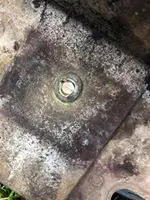
No, there is no coating on the SearMagic cooking grids.
You can use a brass bristle brush to clean SearMagic cooking grids when the grids are hot. When the grids are cold, you can soak them in a Rubbermaid-type container filled with hot water and a grease-cutting dish soap like Dawn, and then scrub with a brass bristle brush or a nylon dish scrubbie.
Every time you use your grill, you can take the grid on the left, flip it over, and move it to the right end of the grill, and slide the other grid(s) over to the left, and then pre-heat the grill for 10 minutes on high. Also, heat the grill to high and let it run for 10 minutes after you finish cooking. This will help to burn off anything that has dripped onto the grids.
There is a wood scraping tool (GGWB5), which is like a large wooden two-tined fork, which is designed to help remove clumps of food, marinades, etc. from between the ridges on the SearMagic cooking grids. There is also a narrow, brass bristle brush (GGWB10) which is designed to fit between the ridges on the SearMagic cooking grids.
Each burner has its own orifice. Replacing each orifice is pretty straightforward and easy to do.
- Remove the burner and remove orifice.
- Install correct orifice.
- Reinstall burner.
On older models, it is on the left inner wall of the grill. On current models, it is on the bottom side of the drip pan.
The battery may need replacing. Unscrew the ignitor button, replace AAA battery.
To remove grease build-up, use Simple Green. or a similar product. After grease is removed, use an oil-based stainless polish. For discoloration and burnt-on stains, MHP Stainless Steel Grill Cleaner (SCC) can be used.
Do not use steel wool.
Yes, discoloration from the intense heat and grease build-up is normal and is not covered under the warranty.
Discoloration and burnt-on stains can be removed with the MHP Stainless Steel Grill Cleaner (SCC). Follow the directions exactly on the back of the bottle and rub with the grain of the stainless.
Never use steel wool to clean a stainless steel grill.
On grills purchased after April 1, 2018. Grills purchased before April 1, 2018 fall under our original lifetime warranty.
You can use a brass bristle brush to clean SearMagic cooking grids when the grids are hot. When the grids are cold, you can soak them in a Rubbermaid-type container filled with hot water and a grease-cutting dish soap like Dawn, and then scrub with a brass bristle brush or a nylon dish scrubbie.
Every time you use your grill, you can take the grid on the left, flip it over, move it to the right end of the grill, slide the other grid(s) over to the left, and then pre-heat the grill for 10 minutes on high. Also, heat the grill to high and let it run for 10 minutes after you finish cooking. This will help to burn off anything that has dripped onto the grids.
There is a wood scraping tool (GGWB5), which is like a large wooden two-tined fork, which is designed to help remove clumps of food, marinades, etc. from between the ridges on the SearMagic cooking grids. There is also a narrow, brass bristle brush (GGWB10) which is designed to fit between the ridges on the SearMagic cooking grids.
Yes, the new cast aluminum drip pan has the same specs as the original drip pan only now it’s made out of cast aluminum.
No, the valves do not have the same specs.
The battery may need to be replaced. Unscrew the ignitor button, and replace it with an AAA battery—positive end down.
The serial number is located on the left end cap of the control panel.
Discoloration and burnt-on stains can be removed with the MHP stainless steel cleaner (SCC). Follow the directions exactly on the back of the bottle and rub with the grain of the stainless.
Never use steel wool to clean a stainless steel grill.
To remove the grease build up first use Simple Green, or a similar product, with a soft cloth rubbing with the grain. After grease is removed, use an oil-based stainless polish and a clean cloth, again rubbing with the grain.
Yes, discoloration from the intense heat and grease build-up is normal and is not covered under the warranty.
Phoenix grills have an expected temperature range between 225˚ – 450˚. However, remember weather conditions factor into the performance of any grill.
A small file can be used to file down each of the ceramic tabs on the ceramic ring to make them hang properly on the burner tip.
No, unfortunately, the wall mount versions of the lamps were discontinued several years ago.
No, due to the delicate nature of the mantles they are prone to breaking and are intended to be lit 24/7.
The dual inverted burner option offers the brightest light followed by the upright burner option. The open flame burner option is for more of an ambiance rather than light.
Unfortunately, we are not able to have the torches UL or CSA approved because currently there are no standards set for them to test against for this type of product.
Our gas lamps use 2.68 cubic ft. per hour, or roughly 1,900 cubic ft. per month or 19 Therms. Simply multiply your cost per therm from your gas provider by 19 to get a rough monthly cost.
All that needs to be replaced when converting gas types is the proper orifice on a gas lamp or torch.
Our Open Flame burner is commonly referred to as a bat wing due to the appearance of the flame when lit.
Weather conditions such as heavy winds and rain will factor into the life expectancy of the mantles due to their delicate nature. As a general rule, you should expect them to last 3 to 4 months.
